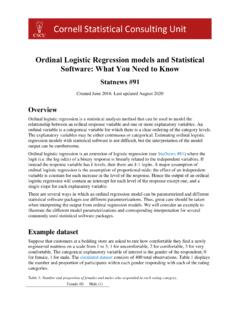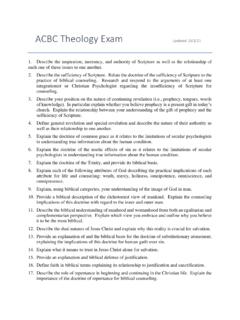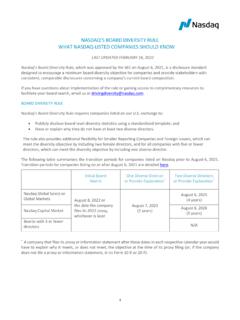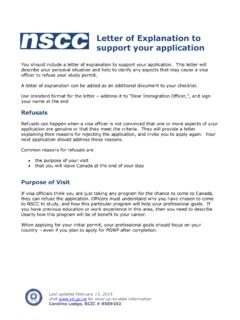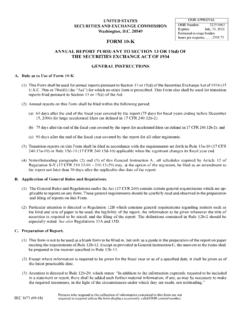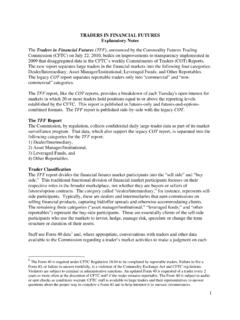Transcription of Interpreting Regression Coefficients for Log-Transformed ...
1 Cornell Statistical Consulting UnitInterpreting Regression Coefficients for Log-Transformed Variables Statnews #83 Cornell Statistical Consulting Unit Created June 2012. Last updated September 2020 Introduction Log transformations are one of the most commonly used transformations, but Interpreting results of an analysis with Log-Transformed data may be challenging. This newsletter focuses on how to obtain estimated parameters of interest and how to interpret the Coefficients in a Regression model involving Log-Transformed variables. A log transformation is often useful for data which exhibit right skewness (positively skewed), and for data where the variability of residuals increases for larger values of the dependent variable. When some variables are Log-Transformed , estimating parameters of interest based on the model may involve more calculation than simply taking the anti-log of certain Regression Coefficients .
2 The log-normal distribution To properly back transform into the original scale we need to understand some details about the log-normal distribution. In probability theory, a log-normal distribution is the distribution of the random variable when ln( ) follows a normal distribution with mean and variance 2. If we think of as the response variable in a Regression model, then log-transforming the response variable and fitting a linear Regression is equivalent to assuming that ln( ) follows a normal distribution. So it will be helpful to understand the behavior of in terms of the parameters of the normally distributed variable ln( ). If ln( ) is normally distributed with mean and variance 2, then the following statements are true: The mean of is + 2/2 The median of is The variance of is ( 2 1) 2 + 2 Suppose we fit a linear Regression model with predictors 1,.., and Log-Transformed response variable ln( ).
3 With typical modeling assumptions this means that ln( ) has a normal distribution with mean = 0+ 1 1+ + and variance 2. Given the coefficient Cornell Statistical Consulting Unit estimates 0,.., , the predicted value for the mean of ln( ) is = 0+ 1 1+ + . It is important to note that exponentiating this predicted value does not provide an estimate of the mean of . Given the three facts stated above, an estimate of the mean of is given by 0+ 1 1+ + + 2/2, where 2 is the residual mean squared error from the fitted Regression model. Coefficient interpretation Interpreting parameter estimates in a linear Regression when some variables are Log-Transformed is not always straightforward. The standard interpretation of a Regression parameter is that a one-unit change in the corresponding predictor is associated with units of change in the expected value of the response variable, holding all other predictors constant.
4 The interpretation of Regression Coefficients when one or more variables are Log-Transformed depends on whether the dependent variable, independent variable, or both are transformed. To understand each of these cases, consider an example in which weight is the dependent variable and height is the only independent variable. Only the dependent variable is transformed Linear change in the independent variable is associated with multiplicative change in the dependent variable. Suppose the fitted model is ln(weight)= + The estimated coefficient for height is 1= , so we would say that an increase of one unit in height is associated with a 100 ( 1 1) percent change in weight. Explanation Given the model ln( )= 0+ 1 , consider increasing by one unit. If we call new the value of after increasing by one unit, then ln( new)= 0+ 1( +1)=ln( )+ 1. Therefore ln( new) ln( )= 1, or 1 = new/ , and 100 ( new 1)=100 ( new )=100 ( 1 1) is the percent change in associated with a one-unit increase in.
5 Only the independent variable is transformed Multiplicative change in the independent variable is associated with linear change in the dependent variable. Fitted model: weight= + (height) Cornell Statistical Consulting Unit Here 1= and we would say that a one-percent increase in height is associated with an increase of 1ln( ) in weight. Explanation The model is = 0+ 1ln( ) and we consider increasing by one percent, new= . Then new= 0+ 1ln( new)= 0+ 1ln( )= 0+ 1ln( )+ 1ln( )= + 1ln( ). This means that new = 1ln( ), so the increase in associated with a one-percent increase in is 1ln( ) Both the independent and dependent variable are transformed Multiplicative change in the independent variable is associated with multiplicative change in the dependent variable. Fitted model: ln(weight)= + (height) In this case, 1= and we would say that a one-percent increase in height is associated with a 100 ( 1 1) percent change in weight, or about a percent change in weight.
6 Explanation Now the model is ln( )= 0+ 1ln( ). Consider increasing by one percent, new= . Then ln( new)= 0+ 1ln( )= 0+ 1ln( )+ 1ln( )=ln( )+ 1ln( ). Therefore ln( new) ln( )= 1ln( ) and ln( new) ln( )= new = 1ln( )= 1 so that the percent change in associated with a one-percent increase in is 100 ( new )=100 ( 1 1) As always if you would like assistance with this topic or any other statistical consulting question, feel free to contact statistical consultants at CSCU. Author: Jing Yang
